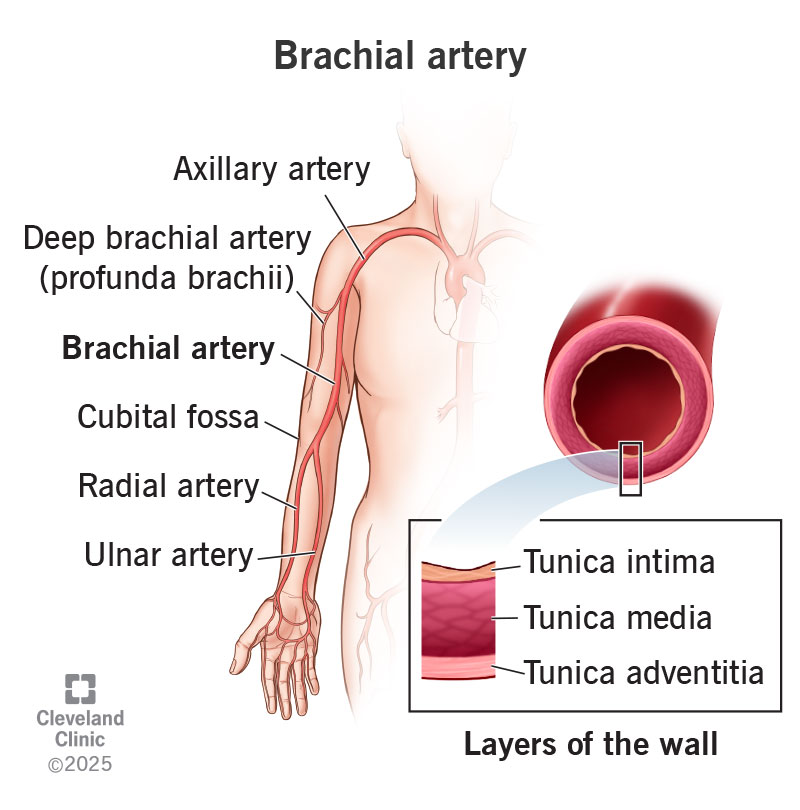Your brachial artery supplies oxygen-rich blood to your upper arm. It starts just below your shoulder as a continuation of your axillary artery and extends all the way down to your elbow. It has several branches that send blood to your forearm and hands. When you check your blood pressure, the cuff squeezes the brachial artery to get a measurement.
Advertisement
Cleveland Clinic is a non-profit academic medical center. Advertising on our site helps support our mission. We do not endorse non-Cleveland Clinic products or services. Policy

Image content: This image is available to view online.
View image online (https://my.clevelandclinic.org/-/scassets/images/org/health/articles/22193-Brachial-Artery)
Your brachial artery is the major blood vessel supplying blood to your upper arm, elbow, forearm and hand. It starts in your upper arm, just below your shoulder, and runs down to the crease in your inner elbow. It has several branches along its route.
Advertisement
Cleveland Clinic is a non-profit academic medical center. Advertising on our site helps support our mission. We do not endorse non-Cleveland Clinic products or services. Policy
You have a brachial artery in each of your arms — so, a right brachial artery and a left brachial artery. These vessels and their branches play an important role in supporting normal blood flow in your upper body.
Your brachial artery and its branches carry oxygen-rich blood to the bones and soft tissues, like muscles, in your arm and hand. These parts all need a steady supply of blood to work as they should. Specific muscles that your brachial artery helps nourish include your biceps, triceps and coracobrachialis.
In a healthcare setting, your brachial artery also has several functions. These include:
Advertisement
Your brachial artery is in your upper arm, along the front part of your bicep and close to your skin’s surface. It starts near your armpit as a continuation of the axillary artery. It ends at the soft crease of your inner elbow. Along its course, the brachial artery runs close to the median nerve.
Several arteries branch from the brachial artery along its course from just below your armpit to your inner elbow. Starting at the top, these include:
Like all blood vessels, your brachial artery is shaped like a tube. Blood flows through its opening. Its walls are made of three layers:
Conditions that can affect your brachial artery include:
Advertisement
Seek immediate medical attention if you have any of the following symptoms:
These can be signs of blood clots in your brachial artery or another artery in your arm. You need medical care right away.
Your brachial artery is one of many blood vessels that keep blood flowing through your upper body. That’s an important job. But this artery also helps your healthcare provider keep a close eye on your health — most often through blood pressure readings.
So, the next time a blood pressure cuff squeezes your upper arm, imagine it’s giving your brachial artery a hug. And take a moment to thank your brachial artery for helping you know what’s happening inside your body!
Advertisement
Learn more about the Health Library and our editorial process.
Cleveland Clinic's health articles are based on evidence-backed information and review by medical professionals to ensure accuracy, reliability, and up-to-date clinical standards.
Cleveland Clinic's health articles are based on evidence-backed information and review by medical professionals to ensure accuracy, reliability, and up-to-date clinical standards.
Cleveland Clinic’s primary care providers offer lifelong medical care. From sinus infections and high blood pressure to preventive screening, we’re here for you.
